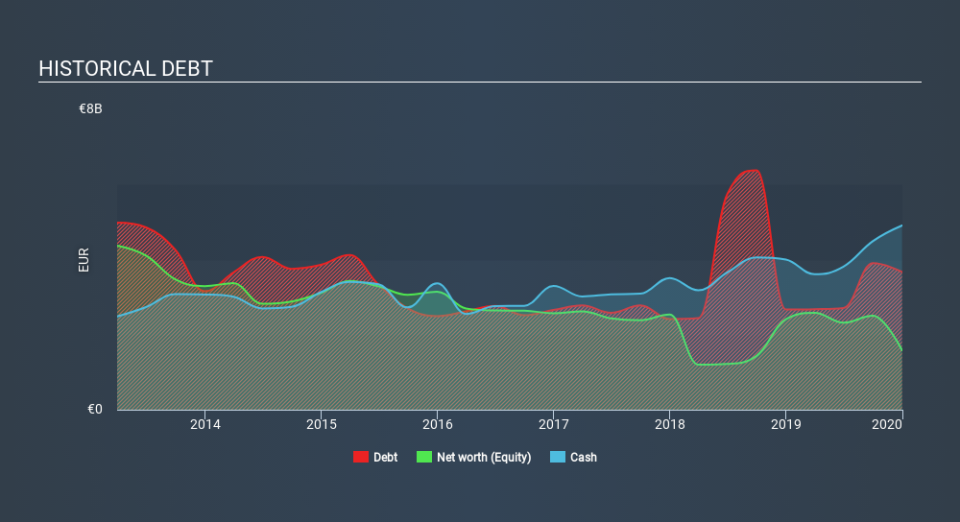HOCHTIEF (ETR:HOT) Seems To Use Debt Quite Sensibly

Warren Buffett famously said, 'Volatility is far from synonymous with risk.' When we think about how risky a company is, we always like to look at its use of debt, since debt overload can lead to ruin. As with many other companies HOCHTIEF Aktiengesellschaft (ETR:HOT) makes use of debt. But the more important question is: how much risk is that debt creating?
Why Does Debt Bring Risk?
Debt and other liabilities become risky for a business when it cannot easily fulfill those obligations, either with free cash flow or by raising capital at an attractive price. If things get really bad, the lenders can take control of the business. However, a more common (but still painful) scenario is that it has to raise new equity capital at a low price, thus permanently diluting shareholders. Having said that, the most common situation is where a company manages its debt reasonably well - and to its own advantage. When we examine debt levels, we first consider both cash and debt levels, together.
Check out our latest analysis for HOCHTIEF
How Much Debt Does HOCHTIEF Carry?
You can click the graphic below for the historical numbers, but it shows that as of December 2019 HOCHTIEF had €3.67b of debt, an increase on €2.67b, over one year. However, its balance sheet shows it holds €4.91b in cash, so it actually has €1.24b net cash.
How Healthy Is HOCHTIEF's Balance Sheet?
Zooming in on the latest balance sheet data, we can see that HOCHTIEF had liabilities of €12.0b due within 12 months and liabilities of €4.27b due beyond that. Offsetting this, it had €4.91b in cash and €6.13b in receivables that were due within 12 months. So its liabilities total €5.28b more than the combination of its cash and short-term receivables.
When you consider that this deficiency exceeds the company's €4.31b market capitalization, you might well be inclined to review the balance sheet intently. Hypothetically, extremely heavy dilution would be required if the company were forced to pay down its liabilities by raising capital at the current share price. HOCHTIEF boasts net cash, so it's fair to say it does not have a heavy debt load, even if it does have very significant liabilities, in total.
Also good is that HOCHTIEF grew its EBIT at 10% over the last year, further increasing its ability to manage debt. The balance sheet is clearly the area to focus on when you are analysing debt. But ultimately the future profitability of the business will decide if HOCHTIEF can strengthen its balance sheet over time. So if you're focused on the future you can check out this free report showing analyst profit forecasts.
Finally, a business needs free cash flow to pay off debt; accounting profits just don't cut it. While HOCHTIEF has net cash on its balance sheet, it's still worth taking a look at its ability to convert earnings before interest and tax (EBIT) to free cash flow, to help us understand how quickly it is building (or eroding) that cash balance. Over the last three years, HOCHTIEF actually produced more free cash flow than EBIT. That sort of strong cash generation warms our hearts like a puppy in a bumblebee suit.
Summing up
Although HOCHTIEF's balance sheet isn't particularly strong, due to the total liabilities, it is clearly positive to see that it has net cash of €1.24b. And it impressed us with free cash flow of €1.0b, being 123% of its EBIT. So we are not troubled with HOCHTIEF's debt use. The balance sheet is clearly the area to focus on when you are analysing debt. But ultimately, every company can contain risks that exist outside of the balance sheet. Take risks, for example - HOCHTIEF has 4 warning signs (and 1 which makes us a bit uncomfortable) we think you should know about.
Of course, if you're the type of investor who prefers buying stocks without the burden of debt, then don't hesitate to discover our exclusive list of net cash growth stocks, today.
If you spot an error that warrants correction, please contact the editor at editorial-team@simplywallst.com. This article by Simply Wall St is general in nature. It does not constitute a recommendation to buy or sell any stock, and does not take account of your objectives, or your financial situation. Simply Wall St has no position in the stocks mentioned.
We aim to bring you long-term focused research analysis driven by fundamental data. Note that our analysis may not factor in the latest price-sensitive company announcements or qualitative material. Thank you for reading.

 Yahoo Finance
Yahoo Finance 